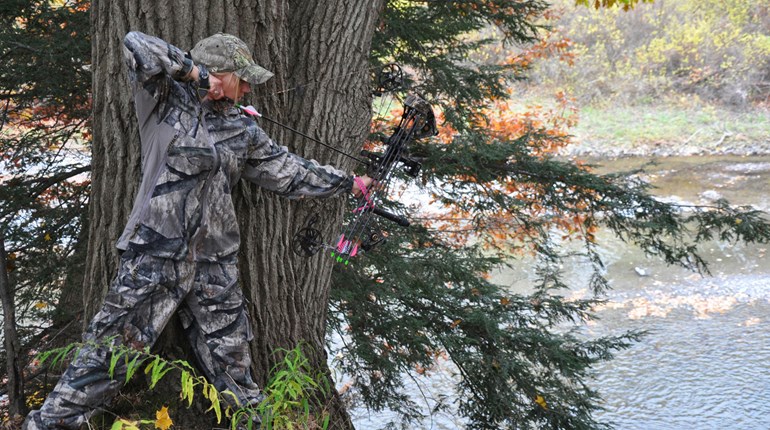
When you’re walking or standing around with a shotgun or rifle for an extended time and you don’t plan to use it imminently—like when you’re hiking to your treestand or back to the truck at the end of the day—you will carry the gun differently than you do when you’re actively hunting. Since you don’t plan to use the gun, you just need a way to carry it that’s comfortable and safe. Here are at least three easy and comfortable ways to safely carry a long gun with a sling.

1. American Carry
American carry is what many of us default to automatically if we haven’t been taught other carry methods. It involves slinging the gun behind your back over your strong-side shoulder, with the muzzle pointed up. You can use your strong-side hand to grip the sling, rest it on the stock or go totally hands-free if your sling doesn’t slip. “For most of us, American carry is most comfortable because it’s on our strong shoulder,” says Gunsite Academy instructor Il Ling New, “so we feel we have more control over the gun. With my elbow I can kind of tuck it in.” One downside of American carry is that your muzzle is behind your back, out of your sight. It’s relatively easy for the gun to swing a little sideways and you won’t know where exactly the muzzle is pointed, potentially creating a safety hazard. This is a relatively minor risk, but it’s something to consider.
American carry also takes a little longer to get out of than the other positions. This is not a big deal if your gun is unloaded and you’re walking back to the truck. But if you’re hiking in grizzly country and there’s a slim-but-not-zero chance you might need to defend yourself, fractions of a second will count. To get the gun off your shoulder and into a shooting position from American carry, reach your support hand over to grasp the forend, then use it to pull the gun off your shoulder and out in front of you. Then you can bring your strong hand to the grip and bring the gun to your face in preparation for a shot.

2. European Carry
In European carry, you will position the sling over your weak-side shoulder with the gun in front of you, with the muzzle pointed up. You’ll use your weak-side hand on the forearm of the gun to keep it steady and stable. “This is actually my favorite because it’s a nice low-profile position,” says New. “No matter the barrel length, I can keep it close to my body and it won’t stick out too far over my head. It’s also a very comfortable position. I can’t carry a shotgun or a rifle on my strong-side shoulder for hours and hours on end—I need an alternative position, and this is a really good one.”
This is also my personal favorite position. I find it comfortable and secure, and I really like that my muzzle is in my peripheral vision at all times so I always know exactly where it’s pointed.
European carry is the fastest position to get out of because your support hand is already exactly where it needs to be for a shot. Just reach your strong hand down to the grip and shrug your shoulder to release the sling, and the gun is ready to come up to your face for a proper shooting position.

3. African Carry
For African carry, you’ll point your muzzle down and sling the gun behind you over your weak-side shoulder. The muzzle will point at the ground, usually slightly in front of you, because it’s difficult to keep the gun 100 percent vertical in this position. “This is the lowest-profile position, so if I need to sneak along on an animal, I can get really low and small and hide my profile,” says New. “And the barrel is pointed down, so if I’m in a heavily wooded area and stuff is falling off of branches and stuff, this is a great one.”
Your weak-side hand will naturally rest on the forearm of the gun to keep it stable, which puts you part of the way toward a good shooting position. To get out of African carry, push the gun up and out with that weak-side hand, then rotate the gun over as your strong hand comes to the grip and prepares to mount the gun in a proper shooting stance. You’ll want to be particularly careful getting back into African carry because you’ll be swinging the muzzle back down. Do so carefully with full muzzle awareness to avoid sweeping your own leg or anything else you’re not willing to destroy.














































